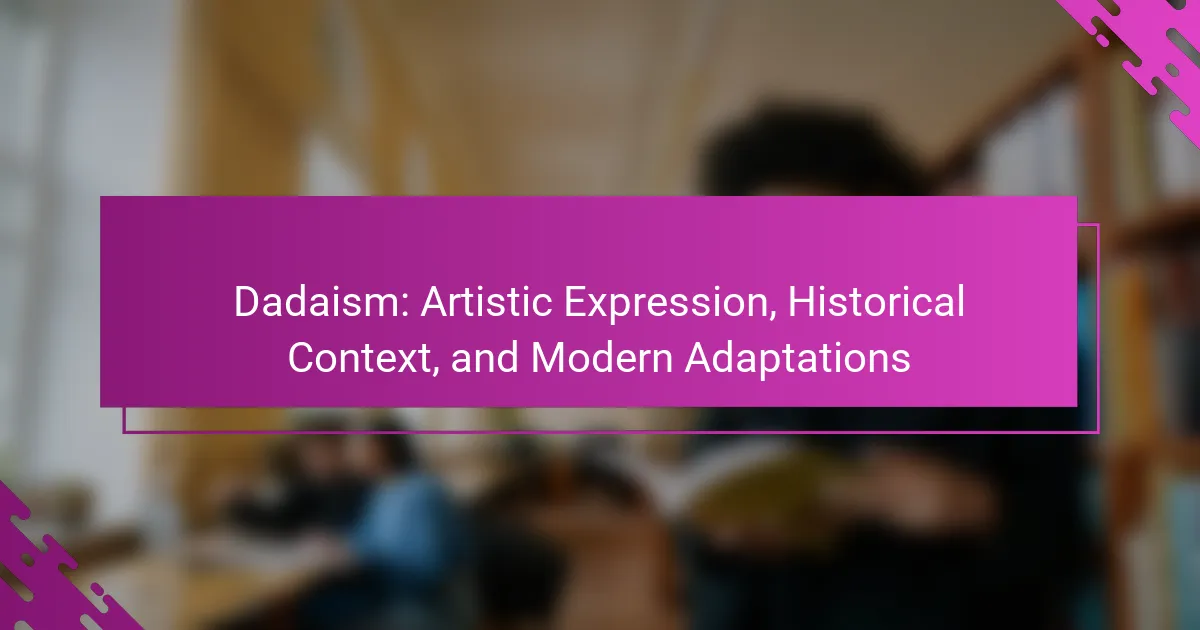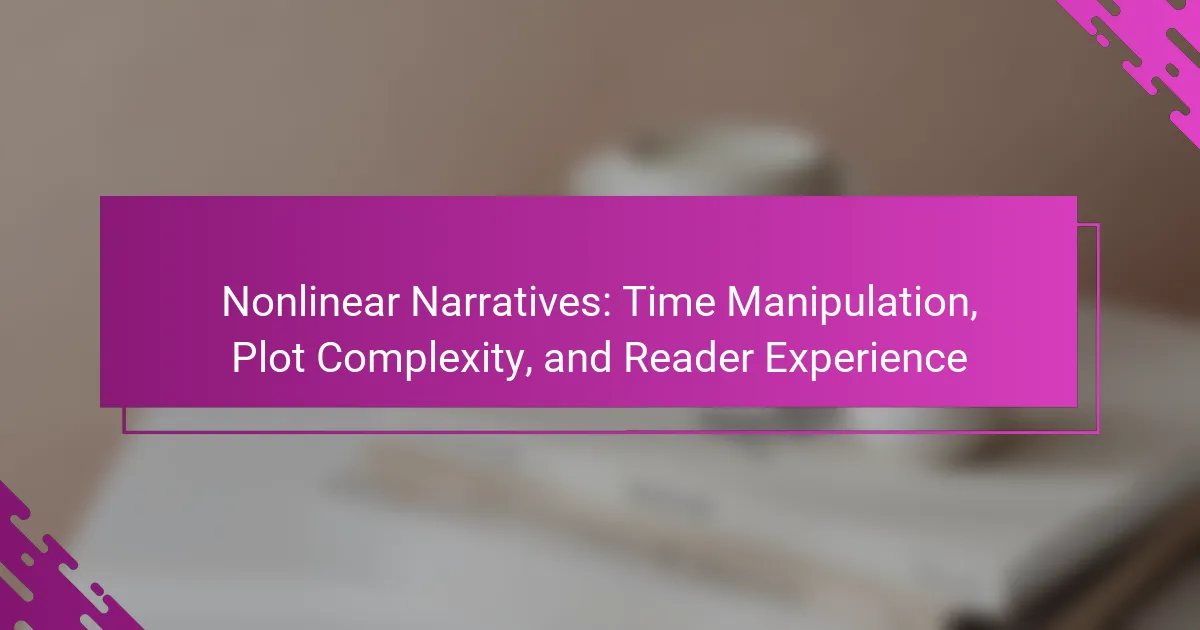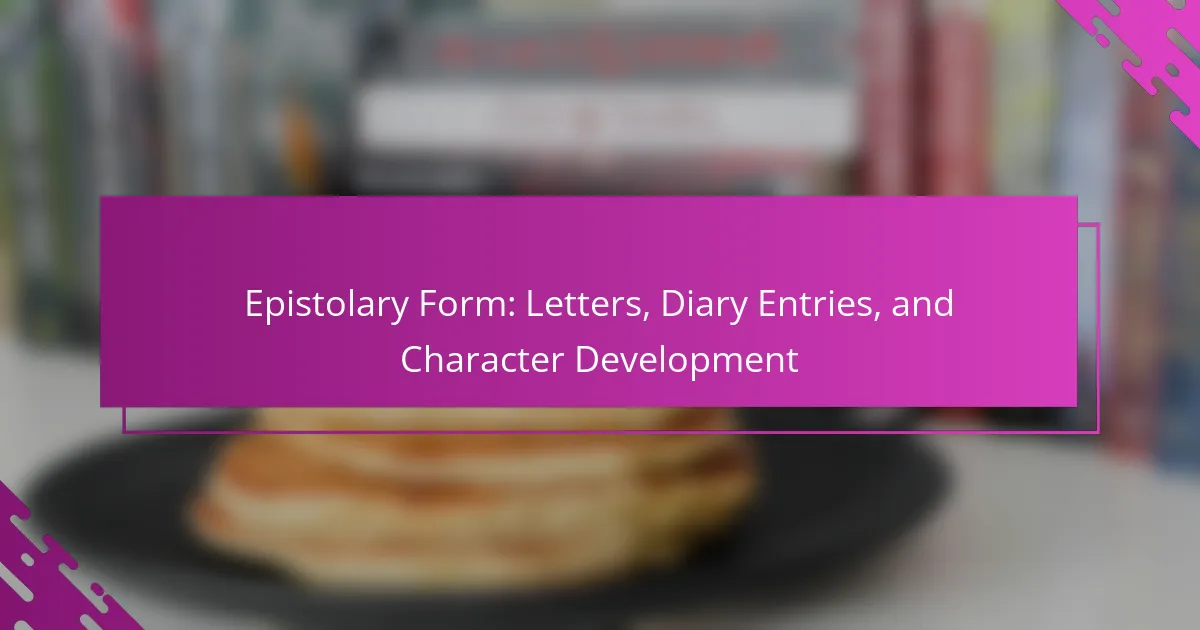Postmodern literature presents unique challenges and rewards for readers. It employs fragmentation to reflect contemporary life, intertextuality to connect various texts, and emphasizes reader interpretation to shape meaning. These elements create a complex narrative style that invites active engagement and diverse interpretations. Understanding these aspects is essential for navigating the intricacies of postmodern works.
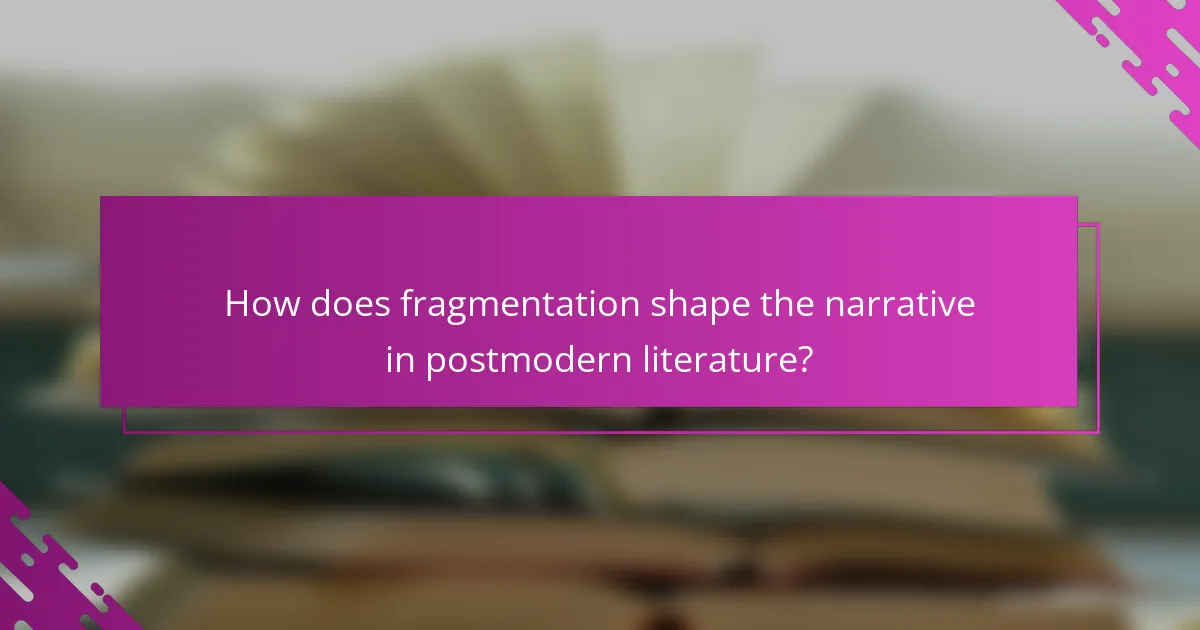
How does fragmentation shape the narrative in postmodern literature?
Fragmentation in postmodern literature creates a disjointed narrative that reflects the complexities of contemporary life. This technique challenges traditional storytelling by presenting multiple perspectives and non-linear timelines. As a result, readers actively engage in piecing together meaning, enhancing their interpretation of the text. Fragmentation serves as a unique attribute that distinguishes postmodern works, fostering a deeper connection between the reader and the narrative. This approach aligns with the broader themes of intertextuality, where references to other texts enrich the reading experience.
What are the key characteristics of fragmented narratives?
Fragmented narratives in postmodern literature are characterized by non-linear storytelling, disjointed timelines, and multiple perspectives. These elements challenge traditional narrative structures and engage readers in active interpretation. Fragmentation enhances themes of uncertainty and the subjective nature of reality. Intertextuality further enriches the narrative by referencing other texts, creating a complex web of meaning. This style often reflects the chaotic nature of contemporary life, inviting readers to piece together the story from disparate elements.
Which authors exemplify fragmentation in their works?
Authors that exemplify fragmentation in their works include Thomas Pynchon, David Foster Wallace, and Don DeLillo. These writers utilize disjointed narratives and intertextuality to challenge traditional storytelling. Their unique styles create complex reading experiences that engage readers in interpretation. For example, Pynchon’s “Gravity’s Rainbow” features non-linear timelines and diverse perspectives, reflecting the chaotic nature of modern life. Wallace’s “Infinite Jest” employs footnotes and nested narratives, further enhancing fragmentation. DeLillo’s “White Noise” captures the disconnection in contemporary society through fragmented prose and ideas.
How does fragmentation affect reader engagement?
Fragmentation can enhance reader engagement by encouraging active interpretation and personal connection to the text. This literary technique disrupts traditional narrative flow, prompting readers to piece together meaning. Readers become co-creators, navigating complex layers of intertextuality. This engagement fosters deeper emotional responses and critical thinking, as readers must actively construct their understanding. Fragmentation thus transforms reading from a passive activity into a dynamic exploration of themes and ideas.
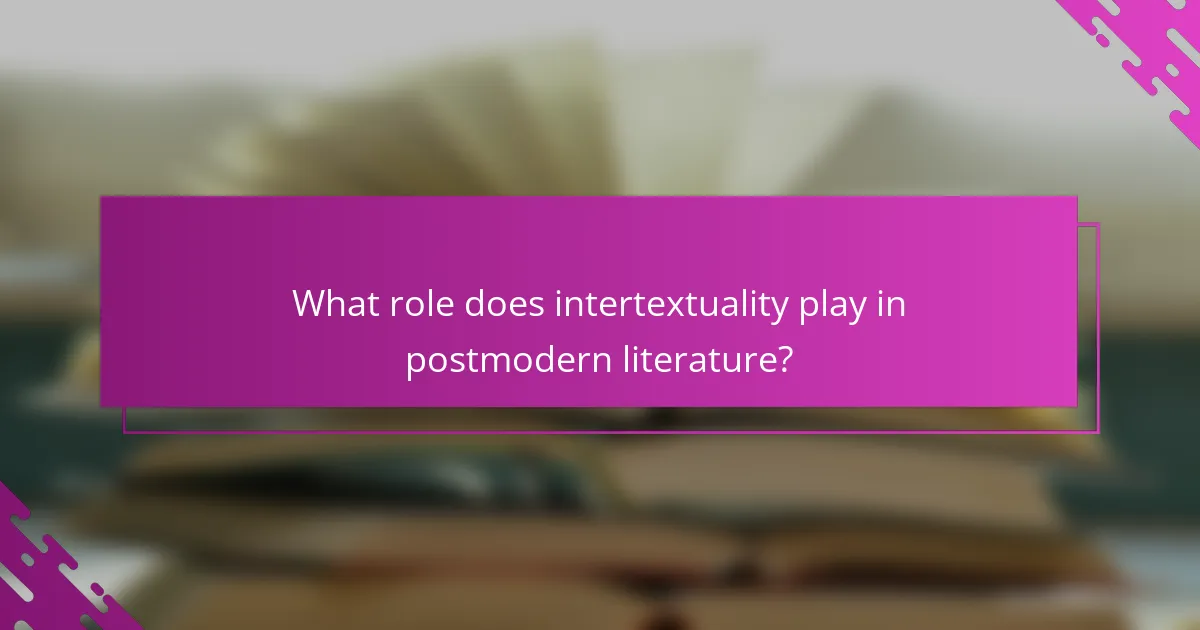
What role does intertextuality play in postmodern literature?
Intertextuality in postmodern literature emphasizes the interconnectedness of texts, shaping reader interpretation. It blurs boundaries between genres and authors, creating a tapestry of references that challenge traditional narratives. This complexity invites readers to engage actively, interpreting meaning through personal and cultural lenses. Intertextuality fosters a unique attribute of postmodern works, as they often incorporate past texts to critique or redefine established ideas. This approach results in a fragmented narrative style, reflecting the postmodern condition and enhancing the reader’s role in meaning-making.
How do references to other texts enhance meaning?
References to other texts enhance meaning by creating intertextual connections that deepen reader interpretation. Postmodern literature often employs fragmentation to challenge linear narratives, encouraging readers to engage actively with the text. This interplay of texts fosters a richer understanding of themes and ideas, as each reference can evoke different meanings based on the reader’s prior knowledge and experiences. Intertextuality transforms reading into a collaborative act, where the reader’s insights shape the narrative. Ultimately, these references enrich the literary experience, illustrating the complexity of meaning in postmodern works.
What are some notable examples of intertextuality in postmodern works?
Notable examples of intertextuality in postmodern works include “Infinite Jest” by David Foster Wallace, which references various cultural texts, and “The Crying of Lot 49” by Thomas Pynchon, which weaves in elements from multiple genres. “Beloved” by Toni Morrison incorporates historical texts and personal narratives, while “White Noise” by Don DeLillo engages with media and consumer culture. “Slaughterhouse-Five” by Kurt Vonnegut blends fiction with historical events, showcasing the interplay between narrative and reality. These works exemplify how intertextuality enriches meaning and reader interpretation.
How does intertextuality challenge traditional authorship?
Intertextuality challenges traditional authorship by blurring the lines between original and derivative works. It emphasizes that texts are interconnected, creating a shared cultural dialogue. This shift encourages readers to interpret meanings based on these relationships rather than solely on the author’s intent. Postmodern literature exemplifies this through fragmented narratives and diverse references, prompting active reader engagement. As a result, the concept of a singular, authoritative voice in literature becomes increasingly complex and decentralized.
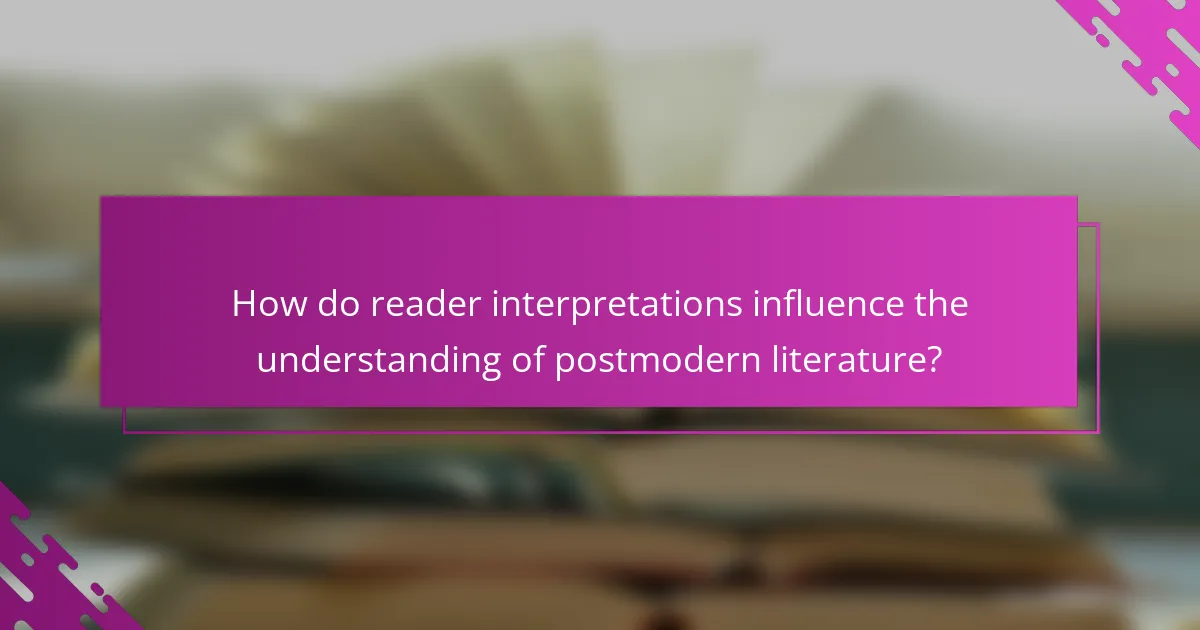
How do reader interpretations influence the understanding of postmodern literature?
Reader interpretations significantly shape the understanding of postmodern literature by emphasizing subjective meaning. Postmodern texts often employ fragmentation and intertextuality, inviting diverse interpretations. This multiplicity allows readers to engage with the narrative in unique ways, reflecting their own experiences and perspectives. As a result, the meaning of a text can shift dramatically based on individual interpretation, highlighting the dynamic relationship between reader and text. The unique attribute of postmodern literature is its reliance on ambiguity, which further encourages varied interpretations.
What factors contribute to diverse interpretations among readers?
Diverse interpretations among readers stem from individual experiences, cultural backgrounds, and varying levels of literary knowledge. Postmodern literature, characterized by fragmentation and intertextuality, invites multiple meanings. Readers’ unique perspectives shape their understanding, allowing for a rich tapestry of interpretations. Contextual factors, such as societal influences and personal beliefs, further enhance this diversity.
How does the reader’s cultural background affect interpretation?
A reader’s cultural background significantly influences their interpretation of postmodern literature. Cultural experiences shape perspectives, leading to diverse understandings of fragmentation and intertextuality.
For instance, readers from collectivist cultures may emphasize communal themes, while those from individualistic backgrounds might focus on personal narratives. This variation creates a rich tapestry of interpretations, reflecting the unique attributes of each reader’s cultural identity.
Moreover, the rare attribute of familiarity with specific cultural references can deepen engagement with the text. Readers who recognize allusions in a work may derive meanings that others miss, enhancing their overall experience.
Ultimately, cultural background serves as a lens through which readers navigate the complexities of postmodern literature, shaping their interpretations and enriching the discourse around it.
What strategies can readers use to navigate complex texts?
Readers can navigate complex texts by employing strategies such as active reading, annotating key ideas, and contextualizing references. Active reading involves engaging with the text through questioning and summarizing. Annotating helps highlight essential themes and intertextual connections. Contextualizing references allows readers to understand the broader literary framework and the significance of fragmentation in postmodern literature. These strategies enhance comprehension and interpretation, facilitating a deeper engagement with the text’s complexities.
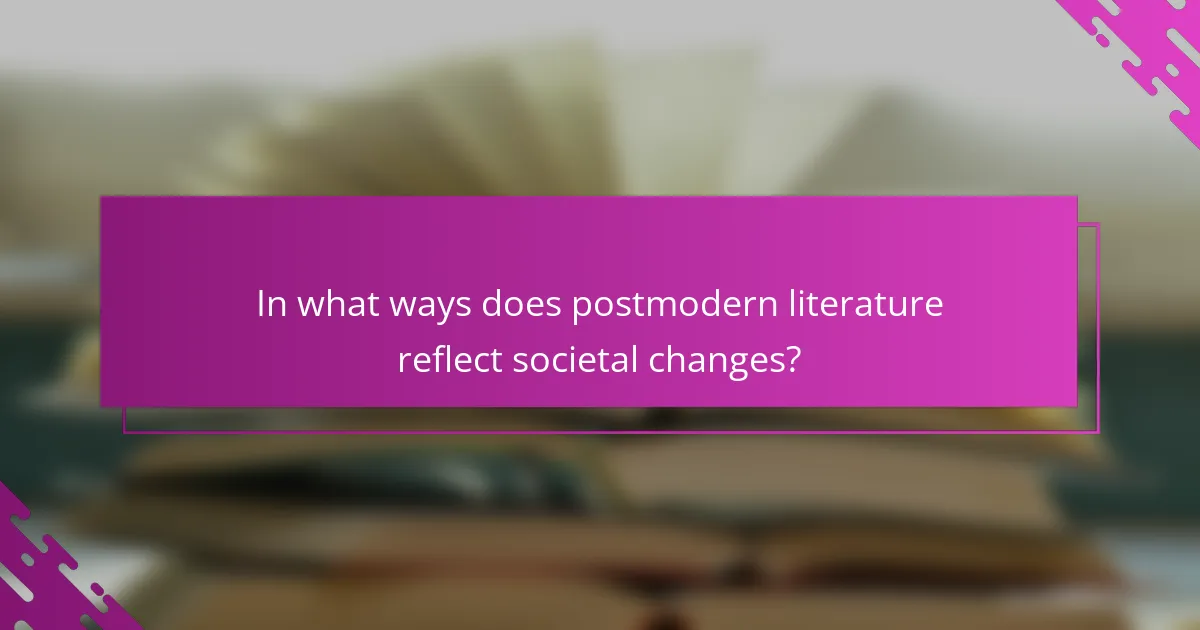
In what ways does postmodern literature reflect societal changes?
Postmodern literature reflects societal changes through fragmentation, intertextuality, and reader interpretation. Fragmentation mirrors the chaos of contemporary life, showcasing disjointed narratives that reflect a fractured society. Intertextuality emphasizes connections between texts, revealing how culture influences literature and vice versa. Reader interpretation becomes crucial, as the meaning of texts often varies based on individual perspectives, highlighting the subjective nature of understanding in a diverse society. This interplay illustrates the complexities of modern existence, making postmodern literature a vital commentary on changing social dynamics.
How do themes of identity and reality manifest in postmodern works?
Themes of identity and reality in postmodern works often intertwine through fragmentation and intertextuality. These literary techniques highlight the complexity of self and truth. Fragmentation disrupts linear narratives, reflecting the multifaceted nature of identity. Intertextuality blurs boundaries between texts, suggesting that meaning is constructed rather than inherent. Reader interpretation becomes essential, as personal experiences shape understanding. This dynamic interplay challenges traditional notions of reality, emphasizing subjective perspectives. Overall, postmodern literature invites exploration of identity as fluid and reality as constructed.
What is the impact of technology on postmodern storytelling?
Technology significantly enhances postmodern storytelling by facilitating fragmentation, intertextuality, and diverse reader interpretations. Digital platforms enable non-linear narratives, allowing authors to break traditional structures. Interactive elements invite readers to engage actively, reshaping their experience and interpretation. As a result, storytelling becomes a collaborative process, reflecting the complexities of contemporary life. The integration of multimedia further enriches narratives, offering unique sensory experiences that traditional formats cannot provide.
Which societal issues are commonly addressed in postmodern literature?
Postmodern literature commonly addresses issues such as identity, fragmentation, and social constructs. These themes reflect the complexities of contemporary society.
The exploration of identity often reveals how personal and collective identities are constructed and deconstructed. Fragmentation illustrates the disjointed nature of reality in modern life, challenging traditional narrative forms. Social constructs are critiqued, questioning established norms and values.
Additionally, postmodern literature engages with technology’s impact on society, highlighting the relationship between individuals and digital culture. This interaction often raises questions about authenticity and alienation in a hyper-connected world.
In summary, postmodern literature serves as a lens to examine multifaceted societal issues, encouraging readers to interpret and engage with diverse perspectives.
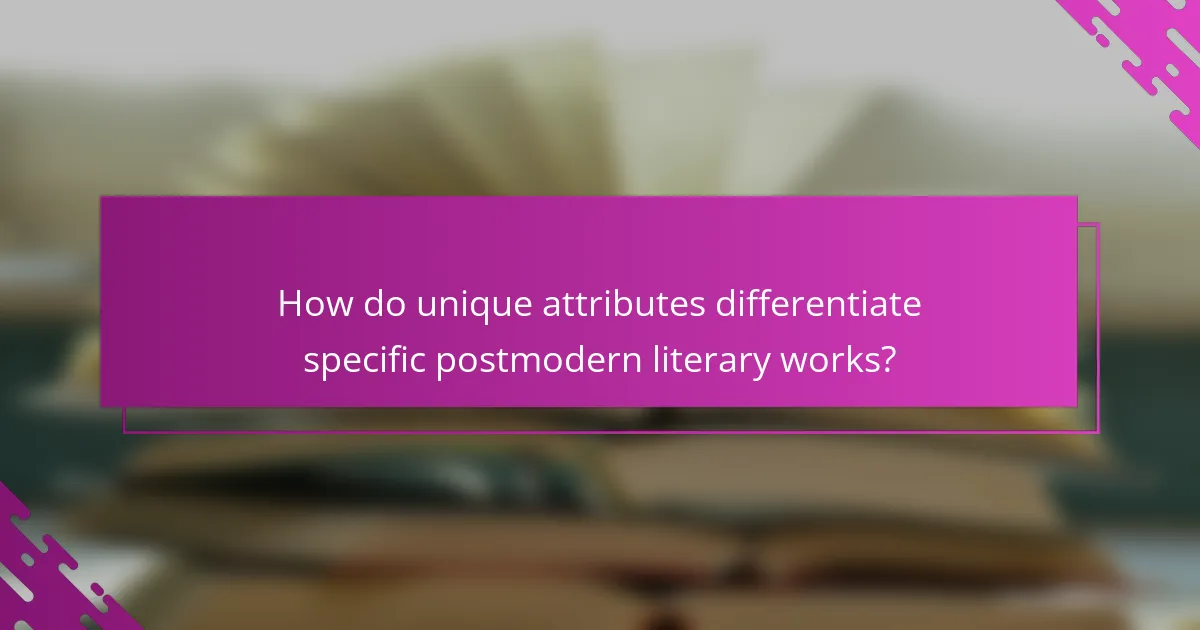
How do unique attributes differentiate specific postmodern literary works?
Unique attributes in postmodern literature, such as metafiction and unreliable narration, set specific works apart by challenging traditional narrative forms. These traits encourage reader engagement and interpretation, fostering a dynamic interaction with the text. For instance, works like “Infinite Jest” utilize fragmentation to reflect complexity in contemporary life, while “The Crying of Lot 49” employs intertextuality to create layered meanings. This differentiation enhances the overall impact of postmodern literature, making it a unique field within literary studies.
What experimental techniques are used by contemporary postmodern authors?
Contemporary postmodern authors employ experimental techniques like fragmentation, intertextuality, and reader interpretation to challenge traditional narrative forms. Fragmentation breaks linear storytelling, creating disjointed narratives that reflect the complexity of reality. Intertextuality weaves references to other texts, prompting deeper engagement and exploration of meaning. Reader interpretation emphasizes the active role of the audience, allowing multiple meanings and personal connections to emerge. These techniques collectively redefine the boundaries of literature, inviting innovative perspectives.
How do cultural contexts influence unique narrative styles?
Cultural contexts significantly shape unique narrative styles in postmodern literature. These influences manifest through fragmentation, intertextuality, and reader interpretation, reflecting diverse societal values and historical backgrounds.
Fragmentation in narrative structure often mirrors the chaotic nature of contemporary life, allowing authors to present disjointed timelines and perspectives. This technique reflects cultural disillusionment and the complexity of identity in a globalized world.
Intertextuality connects texts across cultural boundaries, enriching narratives through references and allusions. This approach fosters deeper engagement, as readers draw on their cultural knowledge to interpret meanings, creating a collaborative reading experience.
Reader interpretation varies widely based on cultural backgrounds, affecting how themes and symbols are perceived. Different cultural lenses can lead to multiple interpretations, emphasizing the subjective nature of meaning in postmodern literature.
What are the implications of metafiction in postmodern literature?
Metafiction in postmodern literature emphasizes self-reflexivity and challenges traditional narrative forms. It blurs the boundaries between fiction and reality, prompting readers to question the nature of storytelling. This genre often employs fragmentation and intertextuality, creating a complex web of references that enriches reader interpretation. As a result, metafiction invites an active engagement, transforming the reader from a passive recipient into a co-creator of meaning.
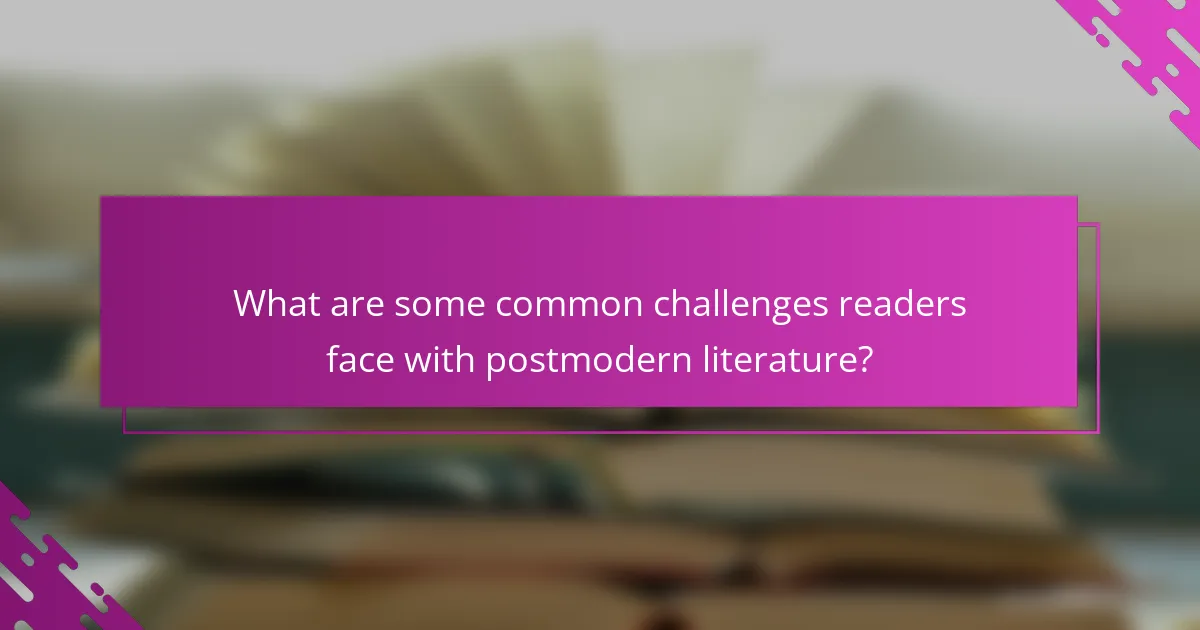
What are some common challenges readers face with postmodern literature?
Readers often face challenges in postmodern literature due to its complex structure and themes. Fragmentation can lead to confusion, as narratives may lack a linear progression. Intertextuality requires familiarity with various texts, making comprehension difficult for some. Additionally, the emphasis on reader interpretation means that understanding can vary widely, leaving readers uncertain about the intended meaning. These factors contribute to a sense of alienation, as the text often resists easy interpretation and demands active engagement.
How can readers overcome confusion with non-linear plots?
Readers can overcome confusion with non-linear plots by actively engaging with the text. They should identify recurring themes and motifs, which serve as anchors. Understanding intertextual references enhances comprehension, as postmodern literature often builds on previous works. Additionally, discussing interpretations with others can clarify complex narratives. Embracing ambiguity allows readers to appreciate the fragmented structure, fostering a more personal connection to the story.
What strategies exist for interpreting ambiguous endings?
Strategies for interpreting ambiguous endings include considering multiple perspectives, analyzing character motivations, and exploring thematic elements. Readers can embrace uncertainty by engaging with the text’s intertextual references and fragmentary structure. Close reading reveals layers of meaning that enhance interpretation. Additionally, discussing interpretations with others can provide fresh insights and deepen understanding.
How do readers cope with the absence of clear resolutions?
Readers cope with the absence of clear resolutions in postmodern literature by embracing ambiguity and engaging in active interpretation. This genre often presents fragmented narratives that challenge conventional storytelling. Readers become co-creators, piecing together meanings from intertextual references and subjective experiences. As a result, they develop personal connections to the text, finding satisfaction in the exploration rather than definitive conclusions. This process highlights the unique attribute of postmodern literature: its ability to stimulate diverse interpretations and emotional responses.
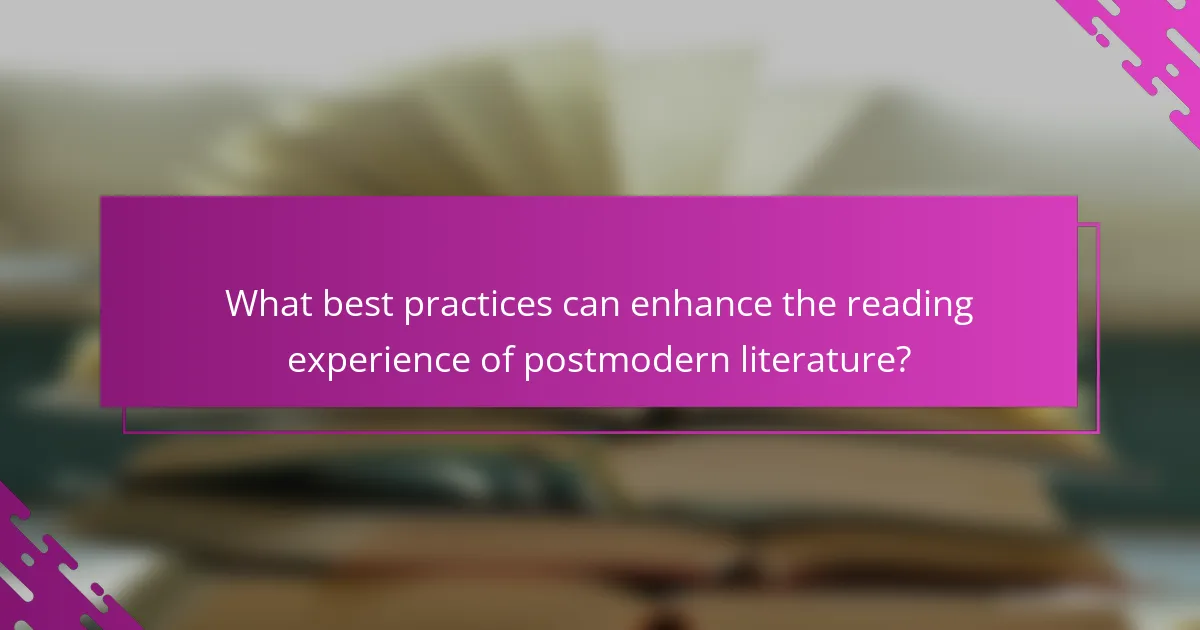
What best practices can enhance the reading experience of postmodern literature?
To enhance the reading experience of postmodern literature, readers should embrace active engagement and critical interpretation. First, approach texts with an open mind to appreciate their fragmented structures and intertextual connections. Second, annotate and take notes, which facilitates deeper understanding and personal reflection. Third, explore multiple interpretations by discussing with others or reading critical analyses. Lastly, allow for pauses and reflections to absorb the complexity and nuance of the narrative.
How can readers prepare for the complexities of postmodern texts?
Readers can prepare for postmodern texts by embracing ambiguity and intertextuality. Understanding that these works often feature fragmented narratives helps in navigating their complexities. Engaging with multiple interpretations enhances reader interpretation skills. Familiarity with literary references allows deeper connections to be made. Lastly, approaching texts with an open mind fosters a more enriching reading experience.
What resources are available for deeper understanding?
Numerous resources enhance understanding of postmodern literature, focusing on fragmentation, intertextuality, and reader interpretation. Key texts include “The Postmodern Condition” by Jean-François Lyotard, which explores the nature of knowledge in a postmodern world, and “Literary Theory: An Introduction” by Terry Eagleton, which provides insights into various literary frameworks. Online platforms like JSTOR and Project MUSE offer access to scholarly articles. Additionally, engaging with literary criticism blogs and podcasts can provide contemporary perspectives.
How can discussion groups facilitate better interpretation?
Discussion groups enhance interpretation by fostering diverse perspectives and collaborative analysis. They create a space for readers to share insights on postmodern literature’s fragmentation and intertextuality. This interaction leads to deeper understanding and richer interpretations. Additionally, members can challenge each other’s views, which sharpens critical thinking and encourages a multifaceted approach to texts. Engaging in dialogue allows for the exploration of unique attributes within the literature, such as how different contexts influence meaning. As a result, discussion groups serve as valuable platforms for collective interpretation.
